Applying GIS in Blue-Green Infrastructure Design in Urban Areas for Better Life Quality and Climate Resilience
Abstract
:1. Introduction
2. Materials and Methods
2.1. Multifunctional Greening and Blue-Green Infrastructural Components
2.2. Geodata Analysis for Optimum BGI Locations
- Group A—refers to forms of land use that preclude the optimal location of the BGI elements analyzed. Surface waters, buildings, roads, communication zones, railways, cemeteries, sports facilities, and forests were included in this category (Figure 2). The BDOT10k database, which provides the required accuracy and timeliness of data, was used to identify these areas [68].
- Group B—relates to elements that determine the optimal placement of the analyzed types of BGI. The geospatial features listed in Table 1 and the datasets that allow for their identification that are conducive to the occurrence of bioswales, infiltration trenches, and green bus stops are mentioned later in this paper.
- Group C—spatial datasets that allow for the identification of urban heat islands (SUHIs) on the analyzed urban area and the analysis of the distribution of residents’ places of residence, taking into account their age (DM—Demography Model).
- Hydrological corrections from SCALGO LIVE [69] (date acquired: 10 March 2023);
- Digital Terrain Model (DTM) from GUGiK [68]—the Head Office of Geodesy and Cartography (date acquired: 10 March 2023);
- Topographic Reference Database (BDOT10k) surface water from GUGiK [68]—the Head Office of Geodesy and Cartography (date acquired: 15 October 2020);
- Topographic Reference Database (BDOT10k) from GUGiK [68]—the Head Office of Geodesy and Cartography (date acquired: 10 March 2023);
- OpenStreetMap (OSM) (date acquired: 10 March 2023).
2.3. MBGI for Bioswale, Infiltration Trench, and Green Bus Stops
2.4. Compilations of Surface Urban Heat Island (SUHI) Model and Demography Model (DM) Applied to the Study Area
3. Results
4. Discussion
5. Conclusions
- The benefits of reducing pollution, improving air quality in urban areas, and thereby improving the health and well-being of residents. In addition, locating BGI elements within the city allows for an increase in biodiversity, thus providing habitats for a variety of plant and animal species. Water conservation is also an important element in relation to the environment, as the blue-green infrastructure helps to filter rainwater.
- Improving the aesthetics of the urban landscape by giving the urban space a unique character. Through the creation of new parks, ponds, and accompanying architectural elements, as well as elements creating urban vegetation, the aesthetics of streets and public spaces are improved, offering residents a place for relaxation, recreation, and social integration.
- Elements of blue-green infrastructure allow for resilience to be built against the effects of climate change, in particular, by providing natural and effective thermal insulation as well as rainwater retention. Green spaces within the city allow for absorption in the event of precipitation, reducing the risk of flooding, as well as the retention of water in the ground in the event of extremely high temperatures.
Author Contributions
Funding
Data Availability Statement
Conflicts of Interest
References
- Zalewski, M.; Wagner, I.; Fratczak, W.; Mankiewicz-Boczek, J.; Parniewki, P. Blue-green city for compensating global climate change. Parliam. Mag. 2012, 350, 2–3. [Google Scholar]
- Bartesaghi-Koc, C.; Osmond, P.; Peters, A. Towards a comprehensive green infrastructure typology: A systematic review of approaches, methods and typologies. Urban Ecosyst. 2017, 20, 15–35. [Google Scholar] [CrossRef]
- Cieślak, I.; Czyża, S.; Szuniewicz, K.; Ogrodniczak, M. Assessment of residential areas of city on the example of Olsztyn. IOP Conf. Ser. Mater. Sci. Eng. 2019, 471, 102001. [Google Scholar] [CrossRef]
- Antoszewski, P.; Świerk, D.; Krzyżaniak, M. Statistical review of quality parameters of blue-green infrastructure elements important in mitigating the effect of the urban heat island in the temperate climate (C) zone. Int. J. Environ. Res. Public Health 2020, 17, 7093. [Google Scholar] [CrossRef] [PubMed]
- Almaaitah, T.; Appleby, M.; Rosenblat, H.; Drake, J.; Joksimovic, D. The potential of Blue-Green infrastructure as a climate change adaptation strategy: A systematic literature review. Blue-Green Syst. 2021, 3, 223–248. [Google Scholar] [CrossRef]
- Badach, J.; Szczepański, J.; Bonenberg, W.; Gębicki, J.; Nyka, L. Developing the Urban Blue-Green Infrastructure as a Tool for Urban Air Quality Management. Sustainability 2022, 14, 9688. [Google Scholar] [CrossRef]
- Siehr, S.A.; Sun, M.; Aranda Nucamendi, J.L. Blue-green infrastructure for climate resilience and urban multifunctionality in Chinese cities. Wiley Interdiscip. Rev. Energy Environ. 2022, 11, e447. [Google Scholar] [CrossRef]
- Arshad, H.S.H.; Routray, J.K. Multi-functional urban greening: A policy review assessing the integration of urban agriculture into the urban planning system of Punjab province, Pakistan. In Urban and Transit Planning: A Culmination of Selected Research Papers from IEREK Conferences on Urban Planning, Architecture and Green Urbanism, Italy and Netherlands (2017); Springer International Publishing: Cham, Switzerland, 2020; pp. 103–111. [Google Scholar] [CrossRef]
- Panlasigui, S.; Spotswood, E.; Beller, E.; Grossinger, R. Biophilia beyond the building: Applying the tools of urban biodiversity planning to create biophilic cities. Sustainability 2021, 13, 2450. [Google Scholar] [CrossRef]
- Korkou, M.; Tarigan, A.K.M.; Hanslin, H.M. The multifunctionality concept in urban green infrastructure planning: A systematic literature review. Urban For. Urban Green. 2023, 85, 127975. [Google Scholar] [CrossRef]
- Bowler, D.E.; Buyung-Ali, L.; Knight, T.M.; Pullin, A.S. Urban greening to cool towns and cities: A systematic review of the empirical evidence. Landsc. Urban Plan. 2010, 97, 147–155. [Google Scholar] [CrossRef]
- Grimmond, C.S.B.; Roth, M.; Oke, T.R.; Au, Y.C.; Best, M.; Betts, R.; Carmichael, G.; Cleugh, H.; Dabberdt, W.; Emmanuel, R.; et al. Climate and more sustainable cities: Climate information for improved planning and management of cities (Producers/Capabilities Perspective). Procedia Environ. Sci. 2010, 1, 247–274. [Google Scholar] [CrossRef]
- Wagner, I.; Krauze, K.; Zalewski, M. Blue aspects of green infrastructure. Sustain. Dev. Appl. 2013, 4, 145–155. [Google Scholar]
- Drosou, N.; Soetanto, R.; Hermawan, F.; Chmutina, K.; Bosher, L.; Hatmoko, J.U.D. Key factors influencing wider adoption of blue-green infrastructure in developing cities. Water 2019, 11, 1234. [Google Scholar] [CrossRef]
- Pluto-Kossakowska, J.; Władyka, M.; Tulkowska, W. Wykorzystanie technologii GIS w analizie zielonej i błękitnej infrastruktury. Rocz. Geomatyki XVIII [Ann. Geomat.] 2020, 1, 33–50. [Google Scholar]
- O’Donnell, E.; Netusil, N.; Chan, F.; Dolman, N.; Gosling, S. International Perceptions of Urban Blue-Green Infrastructure: A Comparison across Four Cities. Water 2021, 13, 544. [Google Scholar] [CrossRef]
- Rall, E.; Hansen, R.; Pauleit, S. The added value of public participation GIS (PPGIS) for urban green infrastructure planning. Urban For. Urban Green. 2019, 40, 264–274. [Google Scholar] [CrossRef]
- Zhou, C.; Wu, Y. A Planning Support Tool for Layout Integral Optimization of Urban Blue–Green Infrastructure. Sustainability 2020, 12, 1613. [Google Scholar] [CrossRef]
- Sörensen, J.; Persson, A.S.; Olsson, J.A. A data management framework for strategic urban planning using blue-green infrastructure. J. Environ. Manag. 2021, 299, 113658. [Google Scholar] [CrossRef] [PubMed]
- Kaur, R.; Gupta, K. Blue-Green Infrastructure (BGI) network in urban areas for sustainable storm water management: A geospatial approach. City Environ. Interact. 2022, 16, 100087. [Google Scholar] [CrossRef]
- Chang, C.R.; Li, M.H.; Chang, S.D. A preliminary study on the local cool-island intensity of Taipei city parks. Landsc. Urban Plan. 2007, 80, 386–395. [Google Scholar] [CrossRef]
- Lee, A.C.K.; Maheswaran, R. The health benefits of urban green spaces: A review of the evidence. J. Public Health 2011, 33, 212–222. [Google Scholar] [CrossRef] [PubMed]
- Völker, S.; Baumeister, H.; Claßen, T.; Hornberg, C.; Kistemann, T. Evidence for the temperature-mitigating capacity of urban blue space—A health geographic perspective. Erdkunde 2013, 67, 355–371. [Google Scholar] [CrossRef]
- Lehmann, S. Low carbon districts: Mitigating the urban heat island with green roof infrastructure. City Cult. Soc. 2014, 5, 1–8. [Google Scholar] [CrossRef]
- Jia, B.Q.; Qiu, K.B. The cooling effect of plain afforestation in the Beijing project and its remote sensing-based valuation. Shengtai Xuebao 2017, 37, 726–735. [Google Scholar] [CrossRef]
- Ampatzidis, P.; Kershaw, T. A review of the impact of blue space on the urban microclimate. Sci. Total Environ. 2020, 730, 139068. [Google Scholar] [CrossRef] [PubMed]
- Xie, Q.; Li, J. Detecting the cool island effect of urban parks in Wuhan: A city on rivers. Int. J. Environ. Res. Public Health 2021, 18, 132. [Google Scholar] [CrossRef] [PubMed]
- Andersson, E.; Langemeyer, J.; Borgström, S.; McPhearson, T.; Haase, D.; Kronenberg, J.; Barton, D.; Davis, M.; Naumann, S.; Röschel, L.; et al. Enabling Green and Blue Infrastructure to Improve Contributions to Human Well-Being and Equity in Urban Systems. BioScience 2019, 69, 566–574. [Google Scholar] [CrossRef]
- Li, J.; Trivic, Z. Impact of “blue-green diet” on human health and wellbeing: A systematic review of potential determinants in shaping the effectiveness of blue-green infrastructure (BGI) in urban settings. Sci Total Environ. 2024, 926, 171397. [Google Scholar] [CrossRef] [PubMed]
- Pinto, L.V.; Inácio, M.; Pereira, P. Green and blue infrastructure (GBI) and urban nature-based solutions (NbS) contribution to human and ecological well-being and health. Oxf. Open Infrastruct. Health 2023, 1, ouad004. [Google Scholar] [CrossRef]
- Andreucci, M.B.; Russo, A.; Olszewska-Guizzo, A. Designing urban green blue infrastructure for mental health and elderly wellbeing. Sustainability 2019, 11, 6425. [Google Scholar] [CrossRef]
- Thomas, C.J.; Bromley, R.D.F. City-centre Revitalisation: Problems of Fragmentation and Fear in the Evening and Night-time City. Urban Stud. 2000, 37, 1403–1429. [Google Scholar] [CrossRef]
- Vernon, B.; Tiwari, R. Place-making through water sensitive urban design. Sustainability 2009, 1, 789–814. [Google Scholar] [CrossRef]
- Rodríguez, M.I.; Cuevas, M.M.; Martínez, G.; Moreno, B. Planning criteria for Water Sensitive Urban Design. WIT Trans. Ecol. Environ. 2014, 191, 1579–1591. [Google Scholar] [CrossRef]
- Hamel, P.; Tan, L. Blue–Green Infrastructure for Flood and Water Quality Management in Southeast Asia: Evidence and Knowledge Gaps. Environ. Manag. 2022, 69, 699–718. [Google Scholar] [CrossRef] [PubMed]
- Saw, L.E.; Lim, F.K.S.; Carrasco, L.R. The relationship between natural park usage and happiness does not hold in a tropical city-state. PLoS ONE 2015, 10, e0133781. [Google Scholar] [CrossRef] [PubMed]
- Olszewska-Guizzo, A.; Sia, A.; Fogel, A.; Ho, R. Can Exposure to Certain Urban Green Spaces Trigger Frontal Alpha Asymmetry in the Brain?—Preliminary Findings from a Passive Task EEG Study. Int. J. Environ. Res. Public Health 2020, 17, 394. [Google Scholar] [CrossRef] [PubMed]
- Dennis, M.; Barlow, D.; Cavan, G.; Cook, P.A.; Gilchrist, A.; Handley, J.; James, P.; Thomon, J.; Tzoulas, K.; Wheater, C.P.; et al. Mapping Urban Green Infrastructure: A Novel Landscape-Based Approach to Incorporating Land Use and Land Cover in the Mapping of Human-Dominated Systems. Land 2018, 7, 17. [Google Scholar] [CrossRef]
- Buldakova, E. Urban Greening and Geo-environmental Safety. Civ. Eng. 2022, 203, 1467–1474. [Google Scholar] [CrossRef] [PubMed]
- Wagner, I.; Januchta-Szostak, A.; Waack-Zając, A. Tools for strategic planning and management of urban water. In Water in the City; Sendzimir Foundation: Kraków, Poland, 2014; pp. 17–29. [Google Scholar]
- O’Donnell, E.C.; Lamond, J.E.; Thorne, C.R. Recognising barriers to implementation of Blue-Green Infrastructure: A Newcastle case study. Urban Water J. 2017, 14, 964–971. [Google Scholar] [CrossRef]
- Mikkili, S.; Panda, S.K.; Agarwal, S. GIS-based integrated approach for sustainable management of ecology and environment with green and blue spaces. Indian J. Ecol. 2021, 48, 931–938. [Google Scholar]
- Chi, Y.L.; Mak, H.W.L. From Comparative and Statistical Assessments of Liveability and Health Conditions of Districts in Hong Kong towards Future City Development. Sustainability 2021, 13, 8781. [Google Scholar] [CrossRef]
- Felce, D.; Perry, J. Quality of life: Its definition and measurement. Res. Dev. Disabil. 1995, 16, 51–74. [Google Scholar] [CrossRef]
- Donati, G.F.A.; Bolliger, J.; Psomas, A.; Maurer, M.; Bach, P.M. Reconciling cities with nature: Identifying local Blue-Green Infrastructure interventions for regional biodiversity enhancement. J. Environ. Manag. 2022, 316, 115254. [Google Scholar] [CrossRef] [PubMed]
- Thekkan, A.F.; George, A.; Prasad, P.R.C.; Joseph, S. Understanding Blue-Green Infrastructure through Spatial Maps: Contribution of Remote Sensing and GIS Technology. In Blue-Green Infrastructure across Asian Countries; Dhyani, S., Basu, M., Santhanam, H., Dasgupta, R., Eds.; Springer: Singapore, 2022; pp. 123–140. [Google Scholar] [CrossRef]
- Gobatti, L.; Bach, P.M.; Scheidegger, A.; Leitão, J.P. Using satellite imagery to investigate Blue-Green Infrastructure establishment time for urban cooling. Sustain. Cities Soc. 2023, 97, 104768. [Google Scholar] [CrossRef]
- Angel, S.; Parent, J.; Civco, D. Urban sprawl metrics: An analysis of global urban expansion using GIS. In Proceedings of the ASPRS Annual Conference 2007: Identifying Geospatial Solutions, Tampa, FL, USA, 7–11 May 2007; American Society for Photogrammetry and Remote Sensing (ASPRS): Baton Rouge, LA, USA, 2007. [Google Scholar]
- Biłozor, A.; Cieślak, I.; Czyża, S.; Szuniewicz, K.; Bajerowski, T. Land-Use Change Dynamics in Areas Subjected to Direct Urbanization Pressure: A Case Study of the City of Olsztyn. Sustainability 2024, 16, 2923. [Google Scholar] [CrossRef]
- Cebrián Abellán, F.; Andrés López, G.; Bellet Sanfeliu, C. The Use of GIS and Multicriteria Techniques for the Socio-Spatial Analysis of Urban Areas in Medium-Sized Spanish Cities. Land 2023, 12, 1115. [Google Scholar] [CrossRef]
- Czyża, S.; Szuniewicz, K.; Cieślak, I.; Biłozor, A.; Bajerowski, T. An Analysis of the Spatial Development of European Cities Based on Their Geometry and the CORINE Land Cover (CLC) Database. Int. J. Environ. Res. Public Health 2023, 20, 2049. [Google Scholar] [CrossRef] [PubMed]
- Mawenda, J.; Watanabe, T.; Avtar, R. An Analysis of Urban Land Use/Land Cover Changes in Blantyre City, Southern Malawi (1994–2018). Sustainability 2020, 12, 2377. [Google Scholar] [CrossRef]
- Yang, X. Satellite monitoring of urban spatial growth in the Atlanta metropolitan area. Photogramm. Eng. Remote Sens. 2002, 68, 725–734. [Google Scholar]
- Ghofrani, Z.; Sposito, V.; Faggian, R. A Comprehensive Review of Blue-Green Infrastructure Concepts. Int. J. Environ. Sustain. 2017, 6, 15–36. [Google Scholar] [CrossRef]
- Ul Din, S.; Mak, H.W.L. Retrieval of Land-Use/Land Cover Change (LUCC) Maps and Urban Expansion Dynamics of Hyderabad, Pakistan via Landsat Datasets and Support Vector Machine Framework. Remote Sens. 2021, 13, 3337. [Google Scholar] [CrossRef]
- Ding, K.; Huang, Y.; Wang, C.; Li, Q.; Yang, C.; Fang, X.; Tao, M.; Xie, R.; Dai, M. Time Series Analysis of Land Cover Change Using Remotely Sensed and Multisource Urban Data Based on Machine Learning: A Case Study of Shenzhen, China from 1979 to 2022. Remote Sens. 2022, 14, 5706. [Google Scholar] [CrossRef]
- Iwaszuk, E.; Rudik, G.; Duin, L.; Mederake, L.; Davis, M.; Naumann, S.; Wagner, I. Elementy błękitno-zielonej infrastruktury. In Błękitno-Zielona Infrastruktura dla Łagodzenia Zmian Klimatu—Katalog Techniczny; Bergier, T., Kowalewska, A., Eds.; Ecologic Institute & Fundacja Sendzimira: Warsaw, Poland, 2019; pp. 5–44. [Google Scholar]
- Morello, E.; Mahmoud, I.; Colaninno, N. Catalogue of Nature-based solutions for urban regeneration. In Energy & Urban Planning Workshop; Morello, E., Mahmoud, I., Eds.; School of Architecture Urban Planning Construction Engineering, Politecnico di Milano: Milan, Italy, 2019; pp. 33–89. [Google Scholar]
- Our World in Data. Available online: https://sdg-tracker.org/ (accessed on 1 December 2023).
- Kimic, K.; Ostrysz, K. Assessment of blue and green infrastructure solutions in shaping urban public spaces—Spatial and functional, environmental, and social aspects. Sustainability 2021, 13, 11041. [Google Scholar] [CrossRef]
- Müller, N.; Kuttler, W.; Barlag, A.B. Counteracting urban climate change: Adaptation measures and their effect on thermal comfort. Theor Appl Clim. 2014, 115, 243–257. [Google Scholar] [CrossRef]
- Sustainable Drainage. Available online: https://www.cambridge.gov.uk/media/5457/suds-design-and-adoption-guide.pdf (accessed on 4 December 2023).
- Townsville City Council. Available online: https://www.townsville.qld.gov.au/__data/assets/pdf_file/0006/12210/WSUD-as-Best-Management-Practices-V3.pdf (accessed on 1 December 2023).
- Shafique, M. A review of the bioretention system for sustainable storm water management in urban areas. Mater. Geoenvironmental 2016, 63, 227–236. [Google Scholar] [CrossRef]
- Individual NWRM Retention Ponds. Available online: http://nwrm.eu/sites/default/files/nwrm_ressources/u11_-_retention_ponds.pdf (accessed on 2 December 2023).
- Lee, J. Green Infrastructure as a Solution to Hydrological Problems: Bioswales and Created Wetlands. UF J. Undergrad. Res. 2019, 21. [Google Scholar] [CrossRef]
- GOV.UK. Rural Sustainable Drainage Systems (RSuDS). Available online: https://assets.publishing.service.gov.uk/media/5a7b956b40f0b645ba3c541b/scho0612buwh-e-e.pdf (accessed on 2 December 2023).
- Główny Urząd Geodezji i Kartografii. Available online: https://geoportal.gov.pl/ (accessed on 2 December 2023).
- SCALGO Live. Available online: https://scalgo.com/live/poland/ (accessed on 2 December 2023).
- U.S. Geological Survey. Landsat 8 Data Users Handbook; NASA: Washington, DC, USA, 2019.
- Jimenez-Munoz, J.C.; Cristobal, J.; Sobrino, J.A.; Sòria, G.; Ninyerola, M.; Pons, X. Revision of the single-channel algorithm for land surface temperature retrieval from landsat thermal-infrared data. IEEE Trans. Geosci. Remote Sens. 2009, 47, 339–349. [Google Scholar] [CrossRef]
- Sobrino, J.A.; Jiménez-Muñoz, J.C.; Sòria, G.; Romaguera, M.; Guanter, L.; Moreno, J.; Plaza, A.; Martínez, P. Land surface emissivity retrieval from different VNIR and TIR sensors. IEEE Trans. Geosci. Remote Sens. 2008, 46, 316–327. [Google Scholar] [CrossRef]
- Gábor, P.; Jombach, S. The relation between the biological activity and the land surface temperature in Budapest. Appl. Ecol. Environ. Res. 2010, 7, 241–251. [Google Scholar] [CrossRef]
- Liu, L.; Zhang, Y. Urban heat island analysis using the landsat TM data and ASTER Data: A case study in Hong Kong. Remote Sens. 2011, 3, 1535–1552. [Google Scholar] [CrossRef]
- Walawender, J.P.; Szymanowski, M.; Hajto, M.J.; Bokwa, A. Land Surface Temperature Patterns in the Urban Agglomeration of Krakow (Poland) Derived from Landsat-7/ETM+ Data. Pure Appl. Geophys. 2014, 171, 913–940. [Google Scholar] [CrossRef]
- Walawender, J.; Hajto, M. Assessment of Thermal Conditions in Urban Areas With Use of Different Satellite Data and Gis. In Proceedings of the EUMETSAT Meteorological Satellite Conference, Bath, UK, 26–30 September 2016. [Google Scholar]
- Sekertekin, A.; Bonafoni, S. Land Surface Temperature Retrieval from Landsat 5, 7, and 8 over Rural Areas: Assessment of Different Retrieval Algorithms and Emissivity Models and Toolbox Implementation. Remote Sens. 2020, 12, 294. [Google Scholar] [CrossRef]
- Valor, G.B. OGIMET—Professional Information about Meteorological Conditions in the World. 2023. Available online: http://ogimet.com/resynops.phtml.en (accessed on 15 August 2023).
- Barsi, J.A.; Barker, J.L.; Schott, J.R. An Atmospheric Correction Parameter Calculator for a Single Thermal Band Earth-Sensing Instrument. Int. Geosci. Remote Sens. Symp. (IGARSS) 2003, 5, 3014–3016. [Google Scholar] [CrossRef]
- Cao, S.; Wang, Y.; Ni, Z.; Xia, B. Effects of Blue-Green Infrastructures on the Microclimate in an Urban Residential Area Under Hot Weather. Front. Sustain. Cities 2022, 4, 824779. [Google Scholar] [CrossRef]
- Jay, O.; Capon, A.; Berry, P.; Broderick, C.; de Dear, R.; Havenith, G.; Honda, Y.; Kovats, R.S.; Ma, W.; Malik, A.; et al. Reducing the health effects of hot weather and heat extremes: From personal cooling strategies to green cities. Lancet 2021, 398, 709–724. [Google Scholar] [CrossRef] [PubMed]
- Lowe, D.; Ebi, K.L.; Forsberg, B. Heatwave early warning systems and adaptation advice to reduce human health consequences of heatwaves. Int. J. Environ. Res. Public Health 2011, 8, 4623–4648. [Google Scholar] [CrossRef] [PubMed] [PubMed Central]
- Matthies, F.; Menne, B. Prevention and management of health hazards related to heatwaves. Int. J. Circumpolar Health 2009, 68, 8–22. [Google Scholar] [CrossRef] [PubMed]
- Rony, M.K.K.; Alamgir, H.M. High temperatures on mental health: Recognizing the association and the need for proactive strategies-A perspective. Health Sci. Rep. 2023, 6, e1729. [Google Scholar] [CrossRef] [PubMed] [PubMed Central]
- Gallagher, J.; Orcutt, J.; Simpson, P.; Wright, D.; Pearlman, J.; Raymond, L. Facilitating open exchange of data and information. Earth Sci. Inf. 2015, 8, 721–739. [Google Scholar] [CrossRef]
- Jeppesen, J.H.; Ebeid, E.; Jacobsen, R.H.; Toftegaard, T.S. Open Geospatial Infrastructure for Data Management and Analytics in Interdisciplinary Research. Comput. Electron. Agric. 2018, 145, 130–141. [Google Scholar] [CrossRef]
- Szuniewicz, K.S.; Cieślak, I.; Czyża, S. The Use of Webgis Services in Public Administration in Poland. In Proceedings of the 15th International Multidisciplinary Scientific GeoConference SGEM2015, Informatics, Geoinformatics and Remote Sensing, Albena, Bulgaria, 18–24 June 2015. STEF92 Technology. [Google Scholar]
- Safarov, I.; Meijer, A.; Grimmelikhuijsen, S. Utilization of open government data: A systematic literature review of types, conditions, effects and users. Inf Polity 2017, 22, 1–24. [Google Scholar] [CrossRef]
- Mak, H.W.L.; Lam, Y.F. Comparative assessments and insights of data openness of 50 smart cities in air quality aspects. Sustain. Cities Soc. 2021, 69, 102868. [Google Scholar] [CrossRef]
- Komosar, A.; Kijanovic, S. Research on the Application of Open Data in the Public Finance Sector. In Proceedings of the 2023 22nd International Symposium INFOTEH-JAHORINA (INFOTEH), East Sarajevo, Bosnia and Herzegovina, 15–17 March 2023; pp. 1–6. [Google Scholar] [CrossRef]
- Zha, F.; Lu, L.; Wang, R.; Zhang, S.; Cao, S.; Baqa, M.F.; Li, Q.; Chen, F. Understanding fine-scale heat health risks and the role of green infrastructure based on remote sensing and socioeconomic data in the megacity of Beijing, China. Ecol. Indic. 2024, 160, 111847. [Google Scholar] [CrossRef]
- Zhou, J.; Yang, M.; Chai, J.; Wu, L. Evaluation on the urban green space layout in the central city of Yuxi based on big data. Front. Environ. Sci. 2022, 10, 1068205. [Google Scholar] [CrossRef]
- La Salandra, M.; Miniello, G.; Nicotri, S.; Italiano, A.; Donvito, G.; Maggi, G.; Dellino, P.; Capolongo, D. Generating UAV high-resolution topographic data within a FOSS photogrammetric workflow using high-performance computing clusters. Int. J. Appl. Earth Obs. Geoinf. 2021, 105, 102600. [Google Scholar] [CrossRef]
- Yu, D.; Fang, C. Urban Remote Sensing with Spatial Big Data: A Review and Renewed Perspective of Urban Studies in Recent Decades. Remote Sens. 2023, 15, 1307. [Google Scholar] [CrossRef]
- Ferreira, N.; Lage, M.; Doraiswamy, H.; Vo, H.; Wilson, L.; Werner, H.; Park, M.; Silva, C. Urbane: A 3D framework to support data driven decision making in urban development. In Proceedings of the IEEE Conference on Visual Analytics Science and Technology (VAST), Chicago, IL, USA, 25–30 October 2015; pp. 97–104. [Google Scholar] [CrossRef]
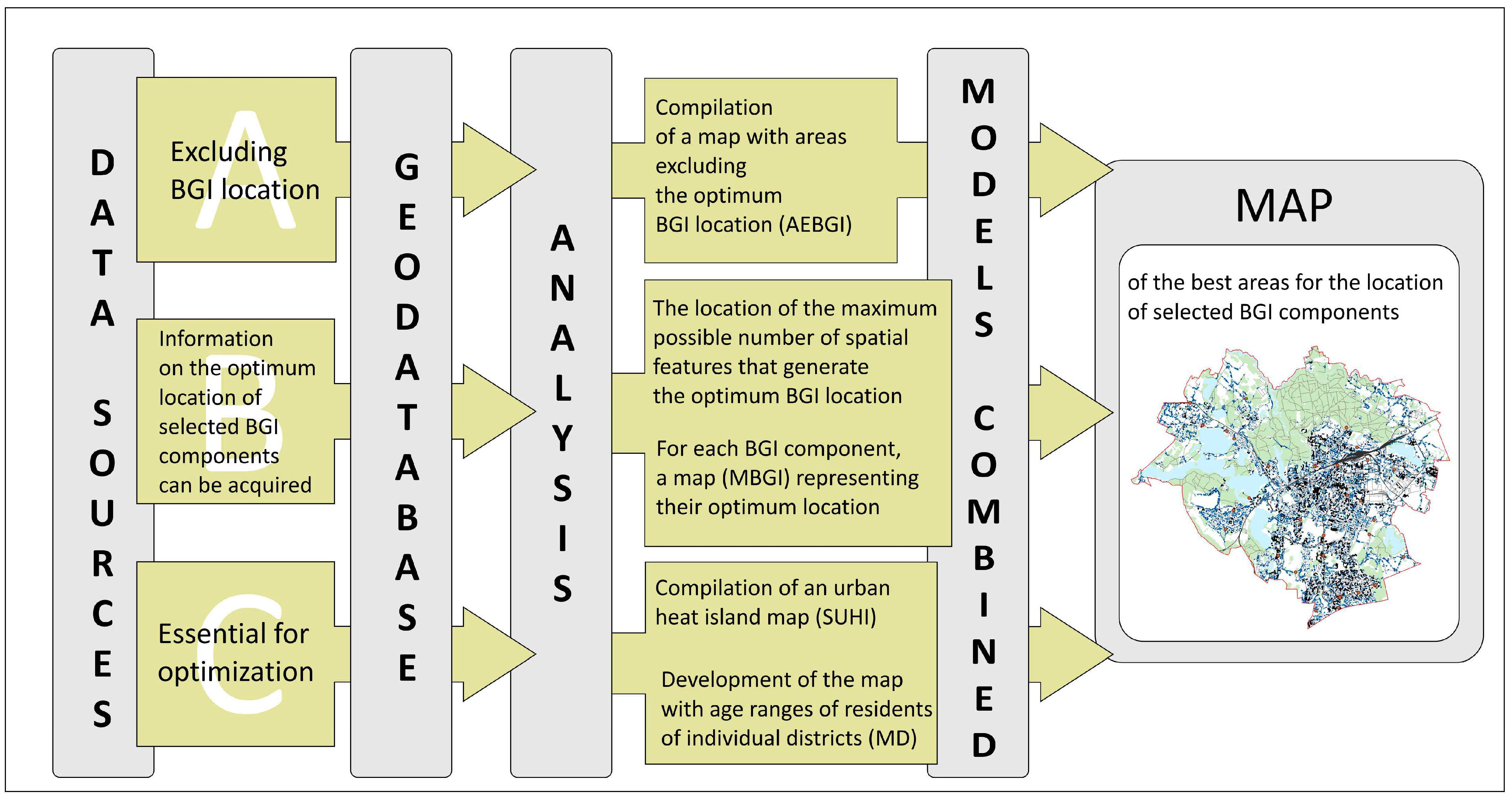
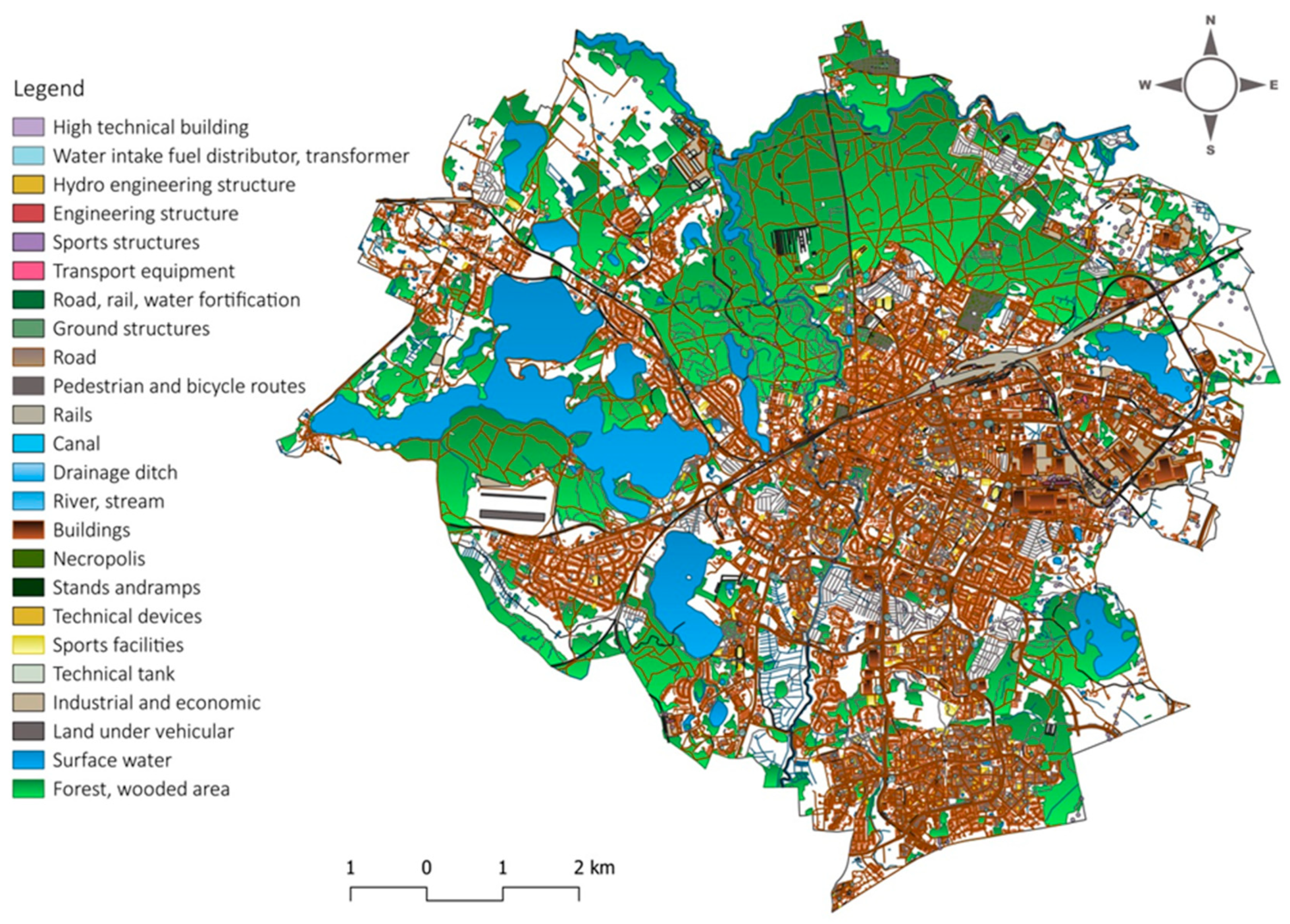
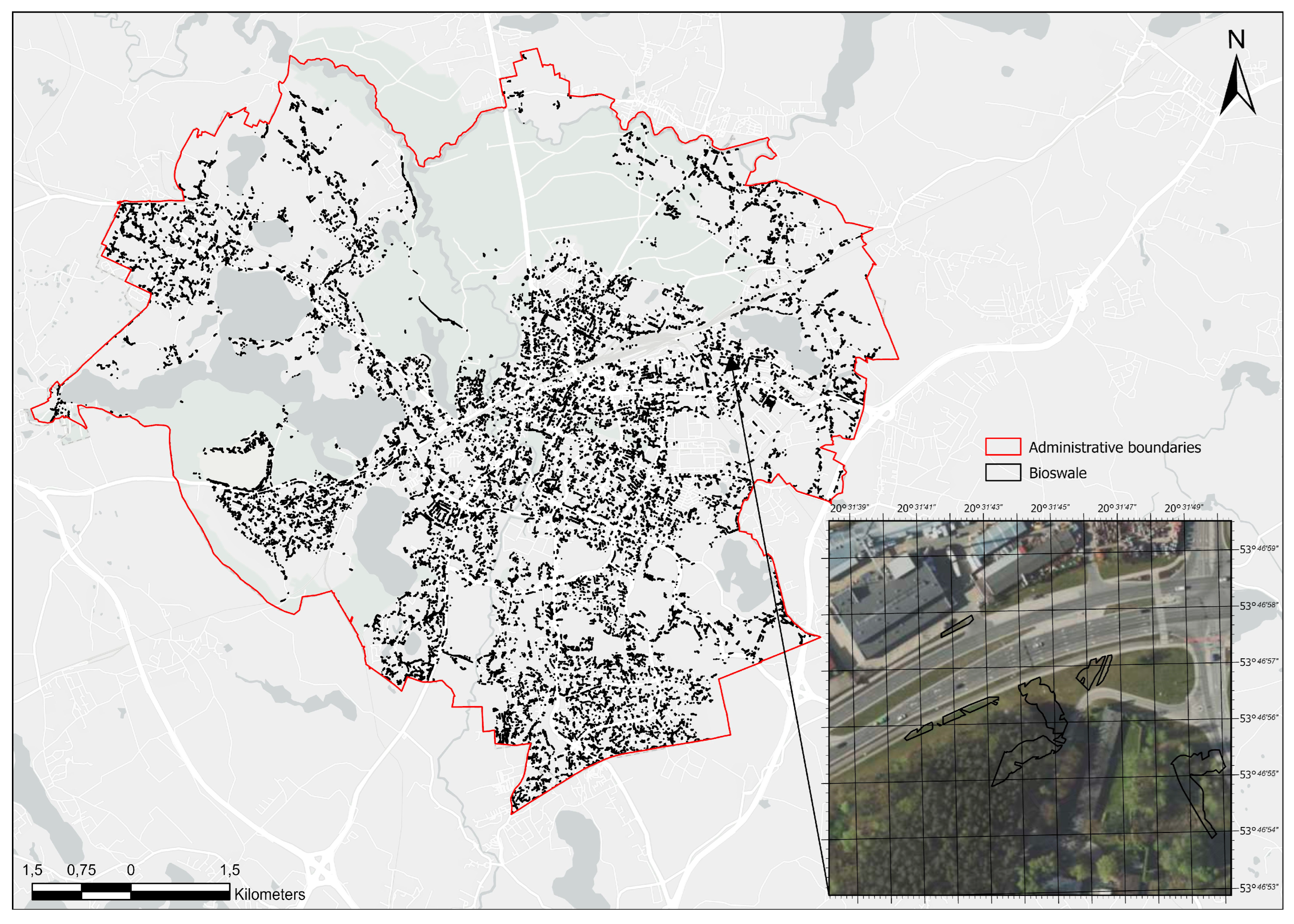
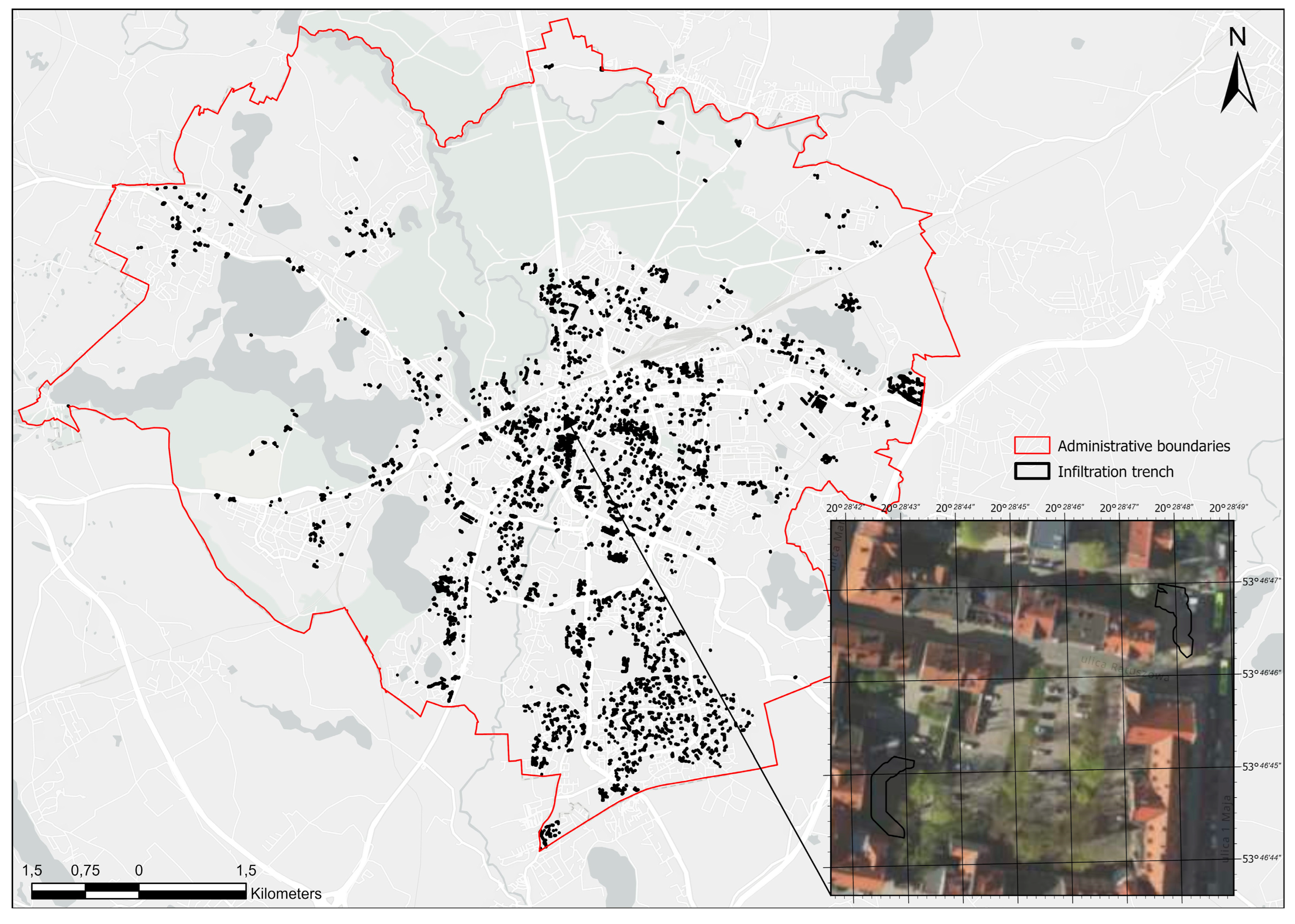
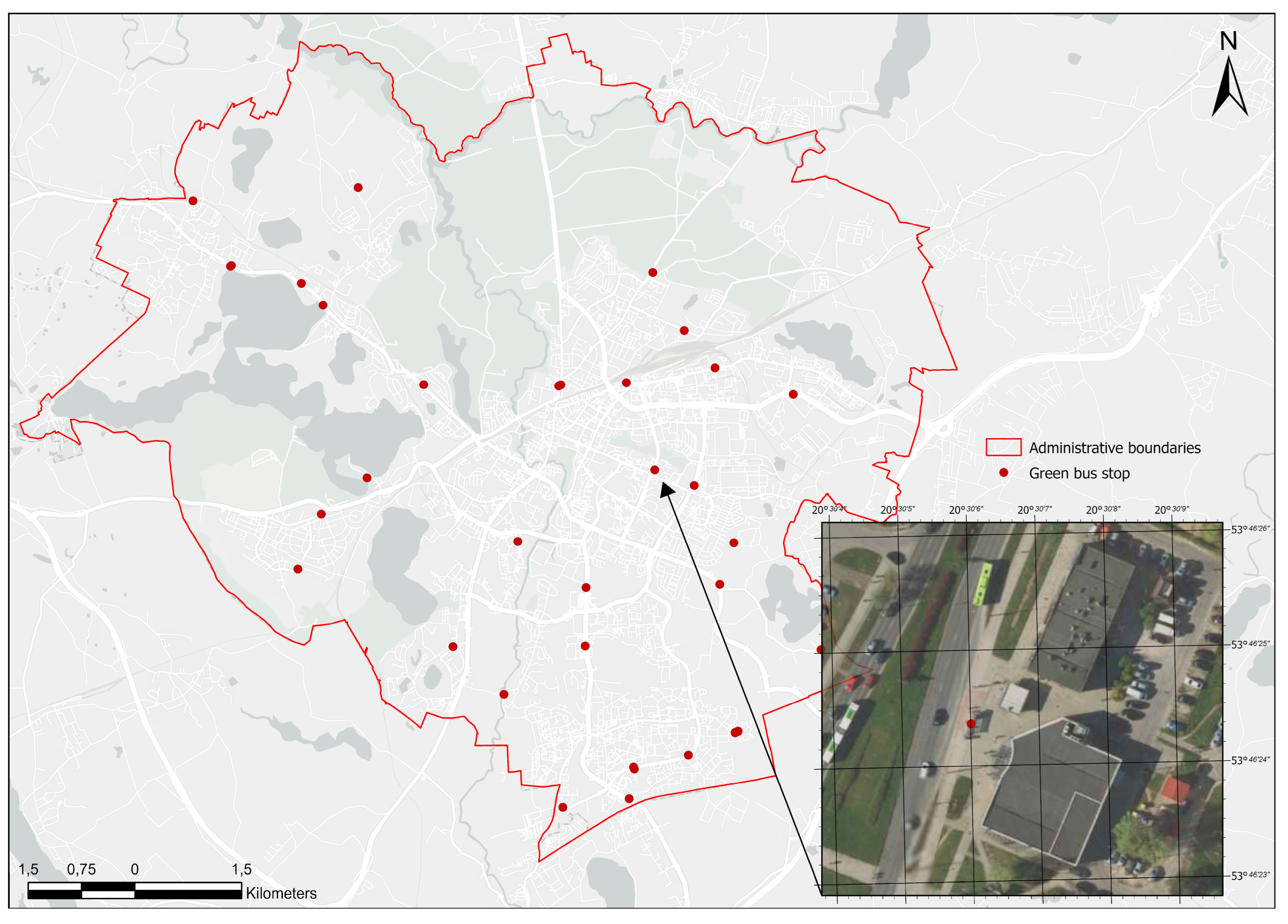
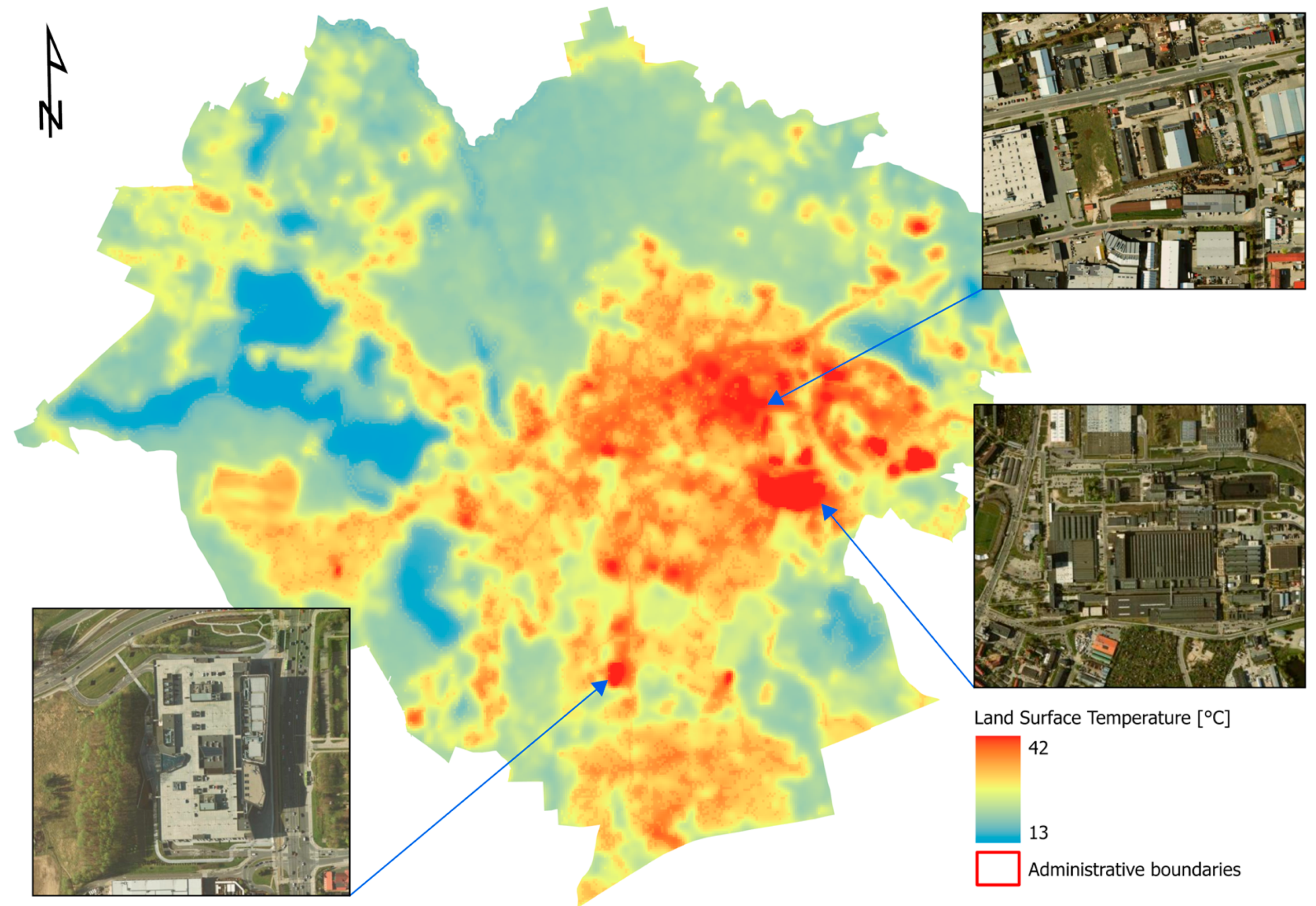

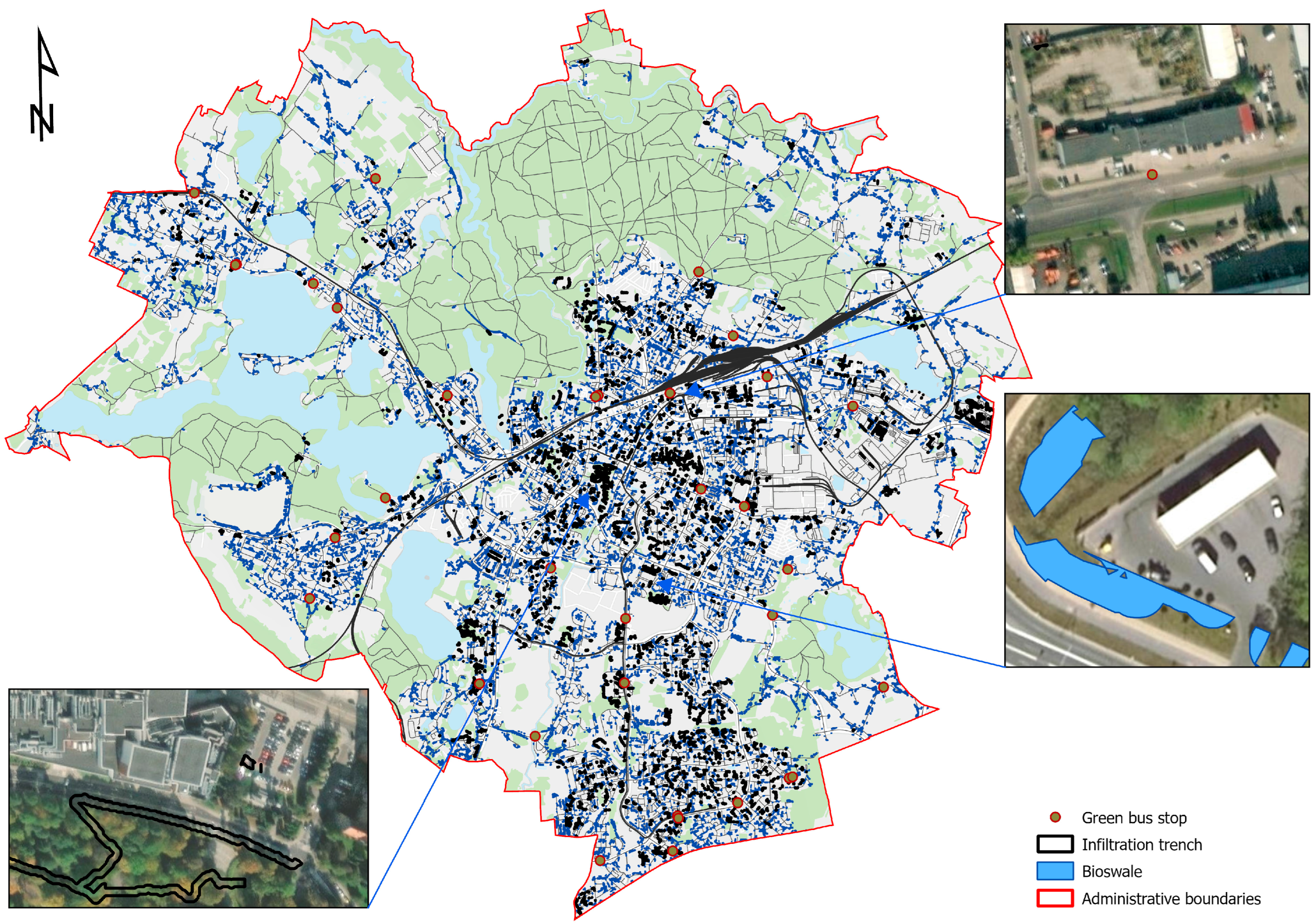
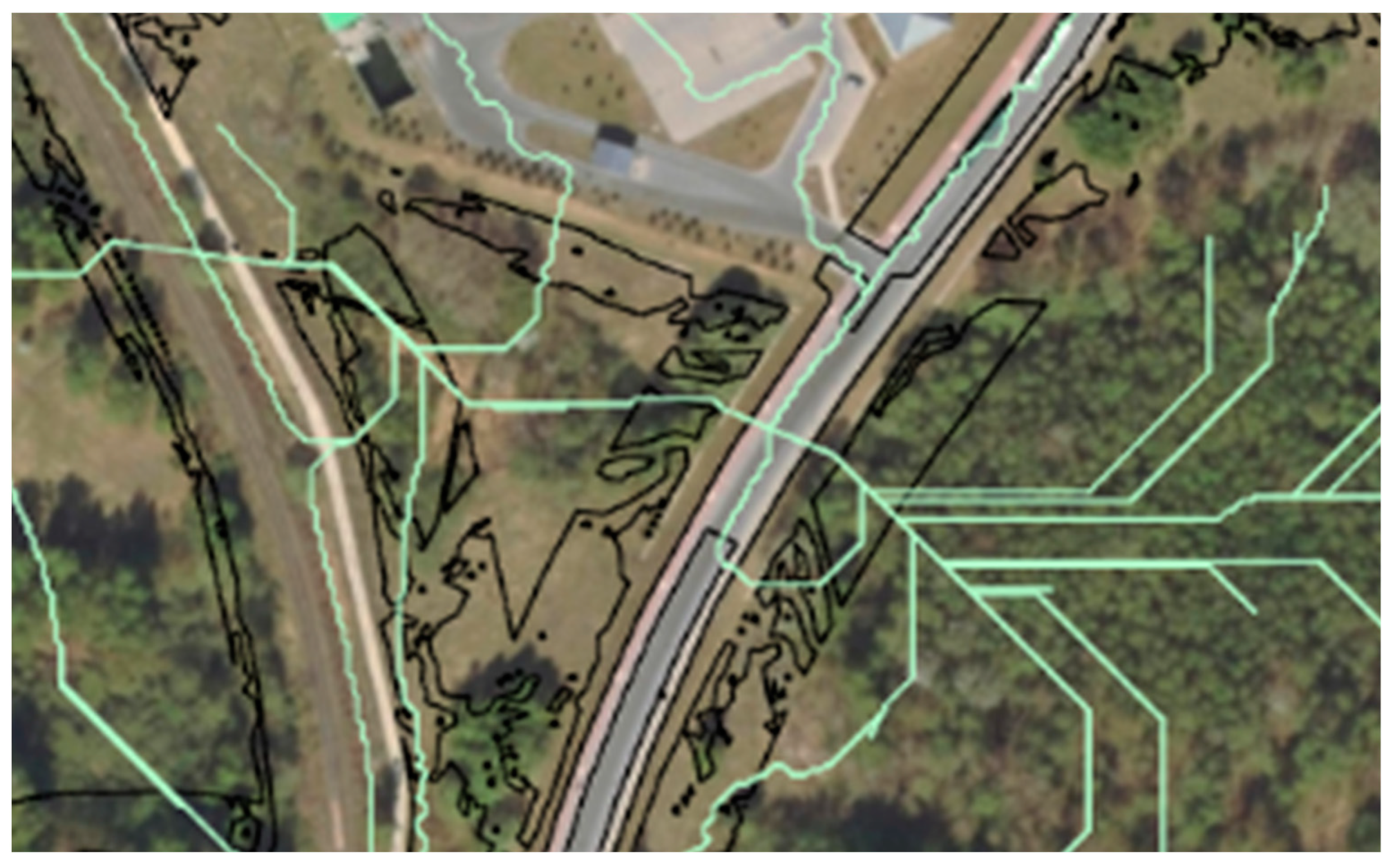
| BGI Components | Bioswale | Infiltration Trench | Green Bus Stop |
|---|---|---|---|
| Definition | a shallow depression covered with vegetation, designed to drain rainwater, with a multi-layered bottom structure; a bioswale collects rainwater, filters it, and gradually infiltrates it into the ground, thus slowing down surface runoff | a shallow excavation filled with crushed stone or stones; the structure increases the soil’s natural ability to absorb water | a component of urban landscape structures comprising a canopy roof and a place where waiting passengers can sit; it is designed to retain rainwater and provide additional green space for people and wildlife |
| Structure | 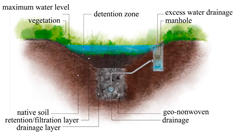 | 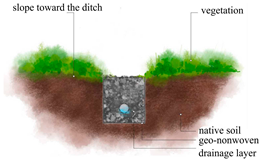 | 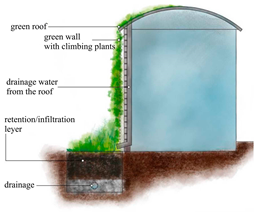 |
| Spatial features conducive to the location |
|
|
|
| Place of application | car parks, roads, walkways, bicycle paths, and public spaces | in the vicinity of playing fields, sports facilities, recreational areas or open public spaces, and car parks | city centers and urbanized areas within reach of public transport—bus stops |
Disclaimer/Publisher’s Note: The statements, opinions and data contained in all publications are solely those of the individual author(s) and contributor(s) and not of MDPI and/or the editor(s). MDPI and/or the editor(s) disclaim responsibility for any injury to people or property resulting from any ideas, methods, instructions or products referred to in the content. |
© 2024 by the authors. Licensee MDPI, Basel, Switzerland. This article is an open access article distributed under the terms and conditions of the Creative Commons Attribution (CC BY) license (https://creativecommons.org/licenses/by/4.0/).
Share and Cite
Czyża, S.; Kowalczyk, A.M. Applying GIS in Blue-Green Infrastructure Design in Urban Areas for Better Life Quality and Climate Resilience. Sustainability 2024, 16, 5187. https://doi.org/10.3390/su16125187
Czyża S, Kowalczyk AM. Applying GIS in Blue-Green Infrastructure Design in Urban Areas for Better Life Quality and Climate Resilience. Sustainability. 2024; 16(12):5187. https://doi.org/10.3390/su16125187
Chicago/Turabian StyleCzyża, Szymon, and Anna Maria Kowalczyk. 2024. "Applying GIS in Blue-Green Infrastructure Design in Urban Areas for Better Life Quality and Climate Resilience" Sustainability 16, no. 12: 5187. https://doi.org/10.3390/su16125187






